Kaloyerou
Visit to download the full and correct content document: https://textbookfull.com/product/basic-concepts-of-data-and-error-analysis-with-introd uctions-to-probability-and-statistics-and-to-computer-methods-panayiotis-nicos-kaloye rou/

More products digital (pdf, epub, mobi) instant download maybe you interests ...
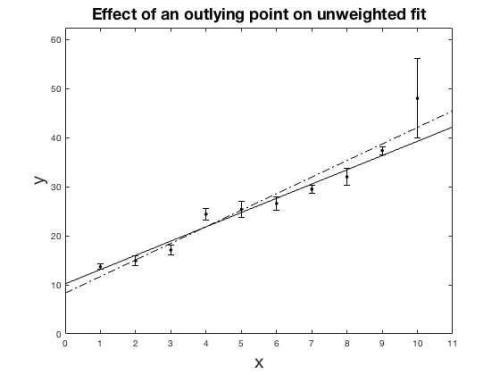
Introduction to error analysis the science of measurements uncertainties and data analysis Merrin
https://textbookfull.com/product/introduction-to-error-analysisthe-science-of-measurements-uncertainties-and-data-analysismerrin/
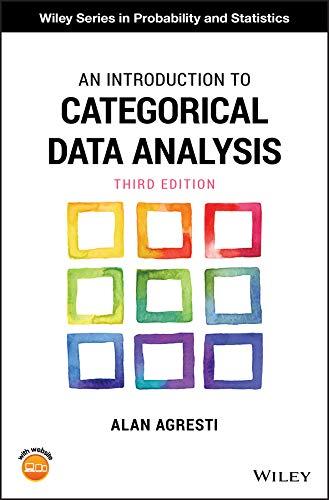
An Introduction to Categorical Data Analysis 3rd Edition Wiley Series in Probability and Statistics Agresti
https://textbookfull.com/product/an-introduction-to-categoricaldata-analysis-3rd-edition-wiley-series-in-probability-andstatistics-agresti/
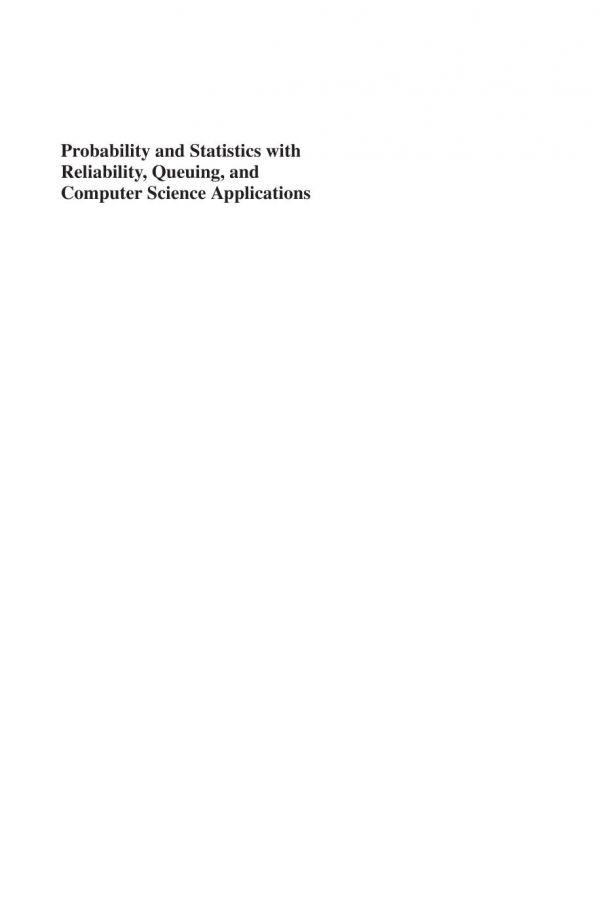
Probability and statistics with reliability queueing and computer science applications Trivedi
https://textbookfull.com/product/probability-and-statistics-withreliability-queueing-and-computer-science-applications-trivedi/
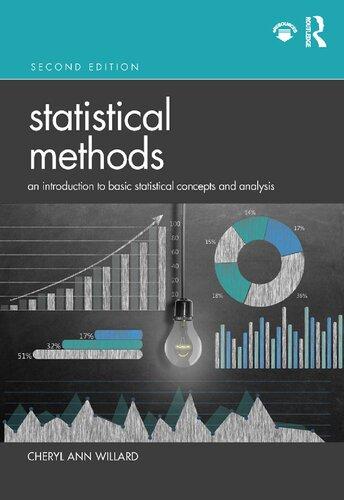
Statistical Methods An Introduction to Basic Statistical Concepts and Analysis 2nd Edition Cheryl Ann Willard
https://textbookfull.com/product/statistical-methods-anintroduction-to-basic-statistical-concepts-and-analysis-2ndedition-cheryl-ann-willard/

Introduction to Statistics and Data Analysis Roxy Peck
https://textbookfull.com/product/introduction-to-statistics-anddata-analysis-roxy-peck/
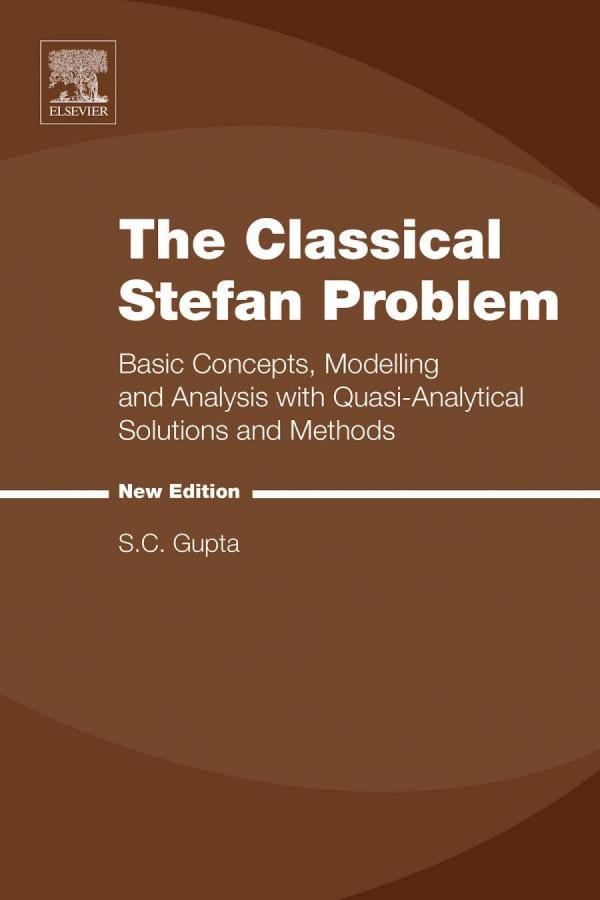
The classical Stefan problem: basic concepts, modelling and analysis with quasi-analytical solutions and methods Gupta S.C.
https://textbookfull.com/product/the-classical-stefan-problembasic-concepts-modelling-and-analysis-with-quasi-analyticalsolutions-and-methods-gupta-s-c/
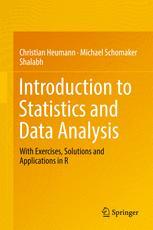
Introduction
to Statistics and Data Analysis With Exercises Solutions and Applications in R 1st Edition
Christian Heumann
https://textbookfull.com/product/introduction-to-statistics-anddata-analysis-with-exercises-solutions-and-applications-in-r-1stedition-christian-heumann/
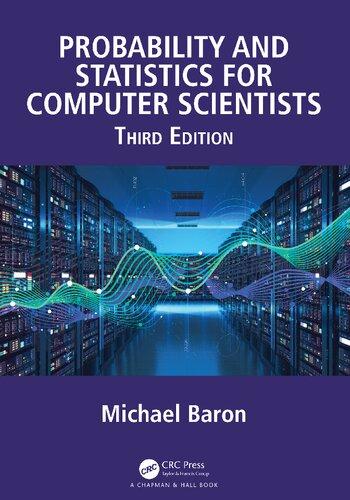
Probability and statistics for computer scientists Third Edition Michael Baron
https://textbookfull.com/product/probability-and-statistics-forcomputer-scientists-third-edition-michael-baron/
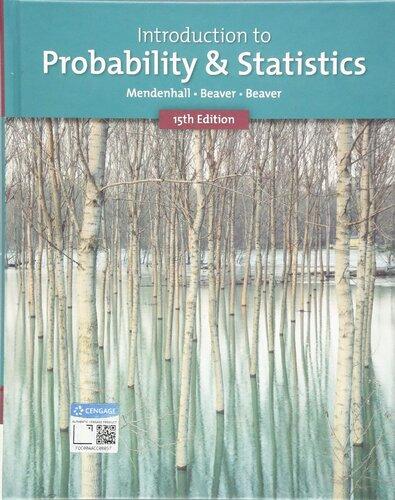
Introduction to Probability and Statistics Metric Edition 1925-2009) Mendenhall
https://textbookfull.com/product/introduction-to-probability-andstatistics-metric-edition-1925-2009-mendenhall/
Panayiotis Nicos Kaloyerou

Basic Concepts of Data and Error Analysis
With Introductions to Probability and Statistics and to Computer Methods



BasicConceptsofDataandErrorAnalysis
BasicConceptsofData andErrorAnalysis
WithIntroductionstoProbability andStatisticsandtoComputerMethods
PanayiotisNicosKaloyerou DepartmentofPhysics, SchoolofNaturalSciences UniversityofZambia Lusaka,Zambia and WolfsonCollege Oxford,UK
ISBN978-3-319-95875-0ISBN978-3-319-95876-7(eBook) https://doi.org/10.1007/978-3-319-95876-7
LibraryofCongressControlNumber:2018949632
© SpringerNatureSwitzerlandAG2018
Thisworkissubjecttocopyright.AllrightsarereservedbythePublisher,whetherthewholeorpart ofthematerialisconcerned,specificallytherightsoftranslation,reprinting,reuseofillustrations, recitation,broadcasting,reproductiononmicrofilmsorinanyotherphysicalway,andtransmission orinformationstorageandretrieval,electronicadaptation,computersoftware,orbysimilarordissimilar methodologynowknownorhereafterdeveloped.
Theuseofgeneraldescriptivenames,registerednames,trademarks,servicemarks,etc.inthis publicationdoesnotimply,evenintheabsenceofaspecificstatement,thatsuchnamesareexemptfrom therelevantprotectivelawsandregulationsandthereforefreeforgeneraluse.
Thepublisher,theauthorsandtheeditorsaresafetoassumethattheadviceandinformationinthis bookarebelievedtobetrueandaccurateatthedateofpublication.Neitherthepublishernorthe authorsortheeditorsgiveawarranty,expressorimplied,withrespecttothematerialcontainedhereinor foranyerrorsoromissionsthatmayhavebeenmade.Thepublisherremainsneutralwithregardto jurisdictionalclaimsinpublishedmapsandinstitutionalaffiliations.
ThisSpringerimprintispublishedbytheregisteredcompanySpringerNatureSwitzerlandAG Theregisteredcompanyaddressis:Gewerbestrasse11,6330Cham,Switzerland
FormywifeGillanddaughterRose
Preface
Thisbookbeganasasetoflecturenotesformylaboratorysessionsatthe UniversityofSwazilandmanyyearsagoandcontinuedtobeusedasImovedto otheruniversities.Overtheyearsthelecturenoteswererefi nedandaddedto, eventuallyexpandingintoashortbook.Ialsonoticedthatmanybooksonpractical physicswereeitheradvancedorverydetailedorboth.Ifelt,therefore,thatthere wasaneedforabookthatfocusedonandhighlightedtheessentialconceptsand methodsofdataanderroranalysisthatareofimmediaterelevanceforstudentsto properlywrite-upandpresenttheirexperiments.Ifeltthatmybook filledthisgap andsoIdecideditmightbeusefultopublishit.
Theoriginallecturenotescomprisedchaptersonetofourofthepresentbook. However,thepublishersuggestedthatthebookshouldbeextended,soitwas decidedtoaddchapter five,whichisanintroductiontoprobabilityandstatistics, andchaptersix,whichintroducescomputermethods.
Forstudentstogetstartedwiththeirexperimentalwrite-ups,onlychaptersoneto fourareneeded.ThoughIhaveattemptedtokeepthesechaptersassimpleas possible,slightlymoreadvancedderivationsofimportantformulahavebeen included.Suchderivationshavebeenpresentedinseparatesectionssocanbeleft outon firstreadingandreturnedtoatalatertime.
Chapter fiveaimstoprovidethetheoreticalbackgroundneededforadeeper understandingoftheconceptsandformulaofdataanderroranalysis.Itisa stand-alonechapterintroducingthebasicconceptsofprobabilityandstatistics. Moregenerally,anunderstandingofthebasicconceptsofprobabilityandstatistics isessentialforanyscienceorengineeringstudent.Thoughthischapterisabitmore advanced,Ihavetriedtopresentitassimplyandconciselyaspossiblewiththe focusbeingonunderstandingthebasicsratherthanoncomprehensivedetail.Ihave alwaysfeltthatithelpsunderstanding,andis,inanycase,intrinsicallyinteresting, tolearnoftheoriginsandtheoriginatorsofthescienceandmathematicsconcepts thatexisttoday.Forthisreason,Ihaveincludedabriefhistoryofthedevelopment ofprobabilityandstatistics.
Chaptersixintroducesthecomputermethodsneededtoperformdataanderror calculations,aswellasthemeanstorepresentdatagraphically.Thisisdoneby usingfourdifferentcomputersoftwarepackagestosolvetwoexamples.However, itishopedthatthemethodsofthischapterwillbeusedonlyafterchaptersoneto fourhavebeenmastered.
Ihaveaddedanumberoftablesandlistsofmathematicalformulaeinthe appendicesforreference,aswellassomebiographiesofscientistsandmathematiciansthathavecontributedtothedevelopmentofprobabilityandstatistics. Itishopedthatthisbookwillservebothasareferencetobecarriedtoeach laboratorysessionandalsoasausefulintroductiontoprobabilityandstatistics.
Lusaka,ZambiaProf.PanayiotisNicosKaloyerou June2018
Acknowledgements
TheauthorparticularlythanksDr.H.V.Mweene(DeanofNaturalSciencesand memberofthePhysicsDepartment,theUniversityofZambia)formeticulous proofreadingofthemanuscriptandfornumeroussuggestionsforimprovingthe manuscript.ThanksarealsoduetoMr.E.M.Ngongaforcarefulproofreading.
3.4.1DerivationofGeneralErrorFormulae
3.7.1Straight-LineGraphs.DeterminationofSlope
5.3ProbabilityDistributions
5.3.1RandomVariables
5.3.2DiscreteProbabilityDistributions
5.3.3DistributionFunctionsforDiscreteRandomVariables
5.3.4ContinuousProbabilityDensityFunctions
5.3.5ContinuousDistributionFunction
5.3.6JointDistributions
5.4TheMeanandRelatedConcepts
5.4.1TheMean
5.5SimpleRandomWalk
5.6Binomial,Poisson,HypergeometricandGaussian
5.6.1BinomialDistribution
5.6.2ThePoissonDistribution
5.6.3TheHypergeometricDistribution
5.6.4TheGaussianDistribution
5.7.1TheWeakLawofLargeNumbers
5.7.2TheCentralLimitTheorem
5.7.3TheStrongLawofLargeNumbers
6UseofComputers
6.1Example1.BuildingHeights
6.1.1SolutionofExample1UsingExcel
6.1.2SolutionofExample1UsingMaple
6.1.3SolutionofExample1UsingMathematica
6.1.4SolutionofExample1UsingMatlab
6.1.5CommentsontheSolutionProgramsofExample1
6.2Example2.AccelerationduetoGravity
6.2.1ExcelSolutionofExample2.Determination oftheAccelerationduetoGravity
6.2.2MapleProgramfortheSolutionofExample2. DeterminationoftheAccelerationduetoGravity
6.2.3MathematicaProgramfortheSolutionofExample2. DeterminationoftheAccelerationduetoGravity .......
6.2.4MatlabProgramfortheSolutionofExample2. DeterminationoftheAccelerationduetoGravity
6.2.5CommentsontheSolutionProgramsofExample2
AbouttheAuthor

Prof.PanayiotisNicosKaloyerou wasbornon November22,1954inLarnaka,Cyprus.Heobtained hisPh.D.inTheoreticalPhysicsin1985fromBirkbeck College,LondonUniversity,underthesupervisionof Prof.DavidBohm,inwhich,basedonBohm’soriginal idea,theCausalInterpretationofBosonFieldswas developed.His firstacademicpositionwasaRoyal SocietyFellowshipheldattheInstitutHenriPoincaré (1987–1988).From1990–1993,heheldaLeverhulme TrustResearchFellowshipattheUniversityofOxford. From1993tothepresent,hehasworkedmostlyin physicsdepartmentsinAfrica:theUniversityof Swaziland(1993–1996),theUniversityofBotswana (1996–2001),andtheUniversityofZambia(2005–present).HismainpublicationsincludetwoPhysics Reportsarticles: AnOntologicalBasisfortheQuantum Theory:aCausalInterpretationofQuantumFields, withD.,BohmandB.J.Hiley,(1987)and TheCausal InterpretationoftheElectromagneticField (1994).
ListofFigures
Fig.1.1Verniercalipers
Fig.1.4The figureshows20divisionsoftheVernierscale covering39mmofthelowermainscale,sothatthe divisionsoftheVernierscaleareeach1.95mmlong 9
Fig.1.5ReadingVerniercalipers.The figureshowsthatthelargest wholenumberofmmbeforethezerooftheVernierscale is50mm.The7thdivisionoftheVernierscaleisaligned withadivisionofthemainscale.Thereadingistherefore 50 þð7 0:05Þ¼ 50.35mmor5.035cm
Fig.1.6Negativezerocorrection.Notethatthezeroofboththetop (inches)andlower(millimetres/centimetres)Vernierscaleis totheleftofthezerosofthemainscale.Sincethe8th divisionontheVernierscaleisalignedwithadivision onthemainscale,thenegativezerocorrectiontobeadded totheVerniercaliperreadingis ð8 0 05Þ¼ 0.4mm 11
Fig.1.7Positivezerocorrection.Notethatthezeroofboththetop (inches)andlower(millimetres/centimetres)Vernierscale istotherightofthezerosofthemainscale.Sincethe8th divisionontheVernierscaleisalignedwithadivisionon themainscale,thepositivezerocorrectiontobesubtracted fromtheVerniercaliperreadingis ð8 0:05Þ¼ 0.4mm 12
Fig.1.8Readingamicrometer(I).Thenearestsleevedivision totheedgeofthethimbleisthe7mmdivision. Thethimbledivisionmostcloselyalignedwiththe referencelineisthe37thdivision.Themicrometerreading istherefore7 þð37 0:01Þ¼ 7:37mm
13
Fig.1.9Readingamicrometer(II).Thenearestsleevedivision totheedgeofthethimbleisthe6.5mmdivision. Thethimbledivisionliesalmostinthemiddlebetween the23rdand24thdivisions,sowemaytake23.5asthe closestdivision.Themicrometerreadingistherefore 6 5 þð23 5 0 01
Fig.1.10Micrometerwithanegativezerocorrection.Thezero ofthethimbleisabovethereferencelineby3divisions sothatthenegativezerocorrectiontobeaddedtothe micrometerreadingis
Fig.1.11Micrometerwithapositivezerocorrection.Thethimble zeroisbelowthereferencelineby3divisionssothat thepositivezerocorrectiontobesubtractedfromthe micrometerreadingis
Fig.2.1Rightandwrongchoicesofscaleandconnectingline
Fig.2.2Theslopeofastraightline
Fig.3.1Resultsfromtwodifferentexperimentsshowingdifferent
Fig.3.2Exampleoffrequencygraphs
Fig.3.3Standarderrorisameasureoftheclosenessofthetrue
Fig.3.4Thecurvedliquidsurfacecangiverisetosystematic parallaxerrors
Fig.3.5Theslopeofastraight-linegraph
Fig.3.6Divisionofdatapointsinthepoints-in-pairsmethod
Fig.3.7Withaxisscalesthatincludetheorigin, c canberead offdirectly
Fig.3.8Pointsaretooclosetogether.Achangeofscaleisneeded
Fig.3.9Tospreadthepointsadequately,ascaleischosen whichexcludestheorigin
Fig.4.1Methodofleastsquares
Fig.5.1Barchartoftheprobabilitydensity p(x)andalinegraph ofthedistributionfunction F(x)ofExample5.3.21 ........... 101
Fig.5.2Plotofthecontinuousprobabilitydensity pðxÞ¼ 1 pp e x2 anditsdistributionfunction F ðxÞ¼ 1 2 ð1 þ erf ðxÞÞ ½ Theshadedareaintheprobabilityfunctiongraph shows PðX 1Þ ...................................... 105
Fig.5.3Plotsofalargeandsmallvariance ....................... 123
Fig.5.4Thefourplotsshowthatthebinomialdistributioncharacterised by(n, p)approachestheGaussiandistribution(seeSect.5.6.4) as n increases 135
Fig.5.5TheplotsshowthePoissondistributionforfourvalues ofthemean l ¼ 2; 5; 10and15 138
Fig.5.6TheplotsshowtheGaussianprobabilitydensity (Gaussiandistribution)formean l ¼ 0andfourvalues ofthestandarddeviation, r ¼ 0 14; 0 21; 0 35and0.64 ....... 146
Fig.5.7AGaussianprobabilitydensityapproximationtoabinomial distributionforthenumberofheadsobtainedin10tosses ofacoin 151
Fig.6.1 Excel spreadsheettocalculatetheheightofabuilding andthestandarderrorinthemean 164
Fig.6.2 Excel barchartsofthefrequenciesandrelativefrequencies ofthebuildingheights,togetherwithjoineddatapoint plotsofthefrequenciesandrelativefrequencies ofthebuildingheights 164
Fig.6.3 Maple histogramofthefrequenciesofthebuildingheights 173
Fig.6.4Anexampletoincludegridlinesina Maple chart(orgraph). Inthisexample,horizontalandverticalgridlinesaregiven individualoptions .................................... 173
Fig.6.5 Maple dataplot,withdatapointsjoinedbyaline, ofthefrequenciesofthebuildingheights .................. 174
Fig.6.6 Maple lineanddataplotoftherelativefrequencies ofthebuildingheights ................................. 174
Fig.6.7 Maple histogramofthefrequenciesofthebuilding heightstogetherwiththe fittedfrequencycurve ............. 174
Fig.6.8 Mathematica histogramofthefrequencies ofthebuildingheights ................................. 181
Fig.6.9 Mathematica barchartofthefrequencies ofthebuildingheights 182
Fig.6.10 Mathematica barchartoftherelativefrequencies ofthebuildingheights 182
Fig.6.11 Mathematica lineanddataplotofthefrequencies ofthebuildingheights 182
Fig.6.12 Mathematica lineanddataplotofrelativefrequencies ofthebuildingheights 183
Fig.6.13 Mathemtica barchartofthefrequenciesofthebuilding heightstogetherwitha fittedfrequencycurve ............... 183
Fig.6.14 Matlab plots.TOP:Barchartsofthefrequenciesandrelative frequenciesofthebuildingheightslabelledbytheirposition in bheights.BOTTOM:Joineddatapointsofthefrequencies andrelativefrequenciesofthebuildingheightsalsolabelled bytheirpositionin bheights ............................ 191
Fig.6.15Thegraphshowsthe fitcurveproducedbythepolynomial ax4 þ bx3 þ cx2 þ dx þ e usingthevaluesofthecoefficients producedby Matlab’s polyfit command .................... 192
Fig.6.16 Matlab plotofthemeasuredbuildingheightslabelled bytheirpositionin ‘bheights’ togetherwitherrorbars ........ 192
Fig.6.17 Excel spreadsheetto find g by firstdeterminingthebest m and c andtheirerrorsusingformulae(4.5),(4.6) and(4.10)to(4.13) ...................................
195
Fig.6.18 Excel spreadsheetto find g by firstdetermining thebest m anditserrorusingformulae(4.14)to(4.16) foralinethroughtheorigin 197
Fig.6.19 Maple plotofthelinewiththebest m andbest c, thelinewiththebest m passingthroughtheorigin andthedatapoints 205
Fig.6.20 Mathematica plotofthelinewiththebest m andbest c, thelinewiththebest m passingthroughtheorigin andthedatapoints 212
Fig.6.21Matlabplots.Topleft:Plotofthelinewiththebest m andbest c togetherwiththedatapoints.Topright:Plot ofthelinewiththebest m passingthroughtheorigintogether withthedatapoints.Bottomleft:Plotofbothlines. Ascanbeseen,thedifferencebetweenthemistoosmall tobeseengraphically.Bottomright:Combinationofboth linesandthedatapoints
Chapter1 UnitsofMeasurement

Chapters1, 2 concernthetreatmentandpresentationofexperimentaldata.Error analysisbeginsinChap. 3
1.1TheNeedforUnits
Whenwegivetheresultsofameasurement,weneedtogivetwopiecesofinformation:oneistheUNITwhichweareusingandtheotheristheNUMBERwhichgives thesize,or‘magnitude’,ofthequantitywhenexpressedinthisunit.
Forexample,ifyouaskmehowmuchmoneyIhave,Ishouldsay‘eighteuros’;I meanthattheamountofmoneyIhaveiseighttimesthevalueofaoneeuronote.IfI merelysay‘eight’Imightmeaneightcents,oreightdollars,oreightcowrie-shells; thestatementmeansnothing.WeneedtheUNITaswellastheNUMBER.
Eachquantityhasitsownproperunit.Wemeasurelengthinmetres,energyin joulesandtimeinseconds.
1.2EarlySystemsofUnits
Before1795,eachcountry,oreachpartofacountry,haditsownunitsforlength, massandtime.The metricsystem (metre-kilogram)wasadoptedinFrancein1795. Inthissystem,eachunitisrelatedtootherunitsforthesamequantitybymultiples often,withGreekprefixesadoptedforthesemultiples.Thissystemhasgradually beenadoptedallovertheworld,firstforscientificworkandlaterfortradeandhome use.In1799inFrance,themetreandkilogramweredeclaredlegalstandardsforall measurements.
©SpringerInternationalPublishingAG,partofSpringerNature2018 P.N.Kaloyerou, BasicConceptsofDataandErrorAnalysis, https://doi.org/10.1007/978-3-319-95876-7_1
BritishImperialUnits (foot-pound-second)wereusedinGreatBritainsince 1824untiltheestablishmentin1960ofthe InternationalSystemofUnits (SI). Before1960,manyEnglishspeakingcountriesusedBritishImperialUnitsorunits derivedfromthem.AnexampleisthesystemusedintheUnitedStates,calledthe UnitedStatesCustomarySystem.Inthissystemthepound(lb)istheunitofforce andtheslugistheunitofmass.OtherBritishImperialUnitsaretheinch(in),foot (ft),yard(yd),mile,pound,stone,gallon(gal)(USandUK)anddegreesFahrenheit (◦ F).AnumberoftheseunitsarestillinusetodayinEnglish-speakingcountries, especiallyinGreatBritainandtheUnitedStates,andcanbefoundeveninnot-so-old textbooks.
Duringthe20thcenturythe CGS (centimetre-gram-second),and MKS (metrekilogram-second)unitswerealsoincommonusebeforeSIunitswereestablishedin 1960.
1.3TheInternationalSystemofUnits.TheSISystem
In1960the11thGeneralConferenceonWeightsandMeasuresadoptedthe Systeme Internationald’Unités (metres-kilograms-seconds)orSIunitsforshort.Before 1960,theSIsystemwascalledtheMKS-system.TheSIsystemhasbeenalmost universallyadoptedthroughouttheworld.TheSIsystemconsistsofthefollowing basicunits:length-metre(m),mass-kilogram(kg),time-second(s),electric current-ampere(A),temperature-kelvin(K),1 quantityofsubstance-mole(m), andluminosity-candela(cd).TheSIbasicunits,alsocalledbaseSIunits,aregiven inTable 1.1,anddefinedinTable 1.2.Allotherunitsarederivedfromtheseseven basicunits(seeTable 1.3).
1.4NamesandSymbolsforSIBaseUnits
Inprintedmaterial,slanting(italic)typeisusedforthe‘symbolforquantity’,and erect(Roman)typeisusedforthe‘symbolforunit’.By‘symbolforquantity’we meanthesymbolusually(butnotnecessarilyalways)usedtorepresentaquantity; forexample,energyisusuallyrepresentedbythecapitalletter E ,whilethesymbol foritsunit,thejoule,isJ.
1 ThekelvinunitwasnamedafterLordKelvin,originallyWilliamThompson(1824–1907).Lord KelvinwasborninBelfast,CountyAntrim,Ireland(nowinNorthernIreland).Hewasanengineer, mathematicianandphysicistwhomadecontributionsmainlytothermodynamicsandelectricity. HeobtaineddegreesfromtheuniversitiesofGlasgowandCambridgeandsubsequentlybecame ProfessorofNaturalPhilosophy(laternamedphysics)attheUniversityofGlasgow,apositionhe heldfor53yearsuntilheretired.
Table1.1 TableofbaseSIunits
Physicalquantity Symbolforquantity SIbase(Basic)unit Symbolforunit
Length l metre m
Mass m kilogram kg
Time s second s
Electriccurrent I ampere A
Temperature T kelvin K
Amountofsubstance n mole mol
Luminousintensity Iv candela cd
Table1.2 TableofdefinitionsofbaseSIunits
Unit Definitionofunit
Metre Thedistancetraveledbylightinavacuumin1/299,792,458ofasecond.
Kilogram Themassequaltothemassoftheinternationalprototypekilogramof platinum-iridiumkeptattheInternationalBureauofWeightsandMeasuresin Sévres,France.
Second Thedurationof9,192,631,770periodsoftheradiationcorrespondingtothe transitionbetweenthehyperfinelevelsofthegroundstateofthecesium-133atom.
Ampere Thecurrentthat,ifmaintainedintwowiresplacedonemetreapartinavacuum, producesaforceof2 × 10 7 newtonspermetreoflength.
Kelvin Thefraction1/273.16ofthethermodynamictemperatureofthetriplepointofwater.
Mole Theamountofsubstancecontainingasmanyelementaryentitiesofthesubstanceas thereareatomsin0.012kgofcarbon-12.
Candela Theintensityofradiationemittedperpendiculartoasurfaceof1/600,000square metreofablackbodyatatemperatureoffreezingplatinumatapressureof 101,325N/m2
NotethatintheSIsystemwedonotusecapitalswhenwritingthenamesofunits, evenwhentheunitnamehappenstobethenameofaperson.Wewritekelvinfor theunitoftemperatureeventhoughtheunitisnamedafterLordKelvin.
1.5SIDerivedUnits
Thereisnobaseunitfor,quantitiessuchasspeed.Wehavetobuildtheunitforspeed fromtwoofthebaseunits.Aunitbuiltinthiswayiscalleda‘derivedunit’.Each derivedunitisrelatedinaverydirectwaytooneormorebaseunits.
SomederivedunitsaregiveninTable 1.3.Amorecompletelistisgivenin Appendix B.4.Noticethatsome,butnotallofthem,havespecialnamesoftheir own.Someunitsarenamedafterthescientistwhocontributedmosttothedevelop-
Table1.3 TableofderivedSIunits
Physicalquantity Symbolforquantity Nameofunit Symboland/or definitionintermsof baseunit
Speed v
Area A
Volume V
Density ρ
Force F
Meterpersecond m s 1
Meter-squaredor squaremetre m2
Metre-cubedorcubic metre m3
Kilogrampercubic metre kg m 3
mentoftheconcepttowhichtheunitrefers,e.g.,thenewton(N),namedafterSir IsaacNewton2 andthejoule(J)namedafterJamesPrescottJoule.3 1.6Prefixesof10
Formanypurposes,theSIbaseorderivedunitistoosmallortoolarge.IntheSI systemwethereforeuseprefixeswhichmaketheunitlargerorsmaller.Forexample, theprefix‘kilo’means‘onethousandtimes’,soakilometreisonethousandtimes aslongasametre.Theabbreviationfor‘kilo’is‘k’,sowecansay1km = 1000 m.TheprefixeswiththeirabbreviationsandmeaningsaretabulatedinTable 1.4.A morecompletelistisgiveninAppendix B.5
2 SirIsaacNewton(1642–1727)wasanEnglishmathematician-naturalphilosopher(naturalphilosophyisnowcalledphysics)borninLincolnshire,England.Aswellasmechanics,hemade contributionsinopticswherehediscoveredthatwhitelightiscomposedofthecoloursoftherainbowbypassingwhitelightthroughaprism.Hismostsignificantcontributionsweretomechanics, where,buildingonfledglingconceptsofmotionhegreatlyadvancedthesubjectusingcalculusfor thefirsttime,developedbyhimselfandlater,separately,byLeibnitz.Heabstractedthreeaspects ofmotionandtheproductionofmotionasbeingfundamentalandstatedthemasthreelaws,now calledNewton’slawsofmotion.Basedontheselawsandontheintroductionofhisuniversallawof gravitationheperformedmanycalculationsamongwhichwasaquantitativedescriptionoftheebb andflowoftides,adescriptionofmanyaspectsofthemotionofplanetsandofspecialfeaturesof themotionoftheMoonandtheEarth.Hepublishedthisworkinaremarkablebook Philosophiae NaturalisPrincipiaMathematica (MathematicalPrinciplesofNaturalPhilosophy)publishedin 1687.Anotherofhismajorworkswashis1704book, Opticks.NewtonstudiedattheUniversityof CambridgeandlaterbecameLucasianprofessorofmathematicsattheUniversityofCambridge.
3 JamesPrescottJoule(1818–1889)wasanEnglishphysicistborninSalford,England.Heismost notedfordemonstratingthatheatisaformofenergy,developingfourmethodsofincreasingaccuracy todeterminethemechanicalequivalentofheat.HestudiedattheUniversityofManchester.
1.7DimensionalAnalysis5
Table1.4 TableofPrefixes of10
1.7DimensionalAnalysis
Itisoftenconvenienttoanalyseformulaeintermsofthreebasicquantities:mass, lengthandtime.Thesearecalleddimensions(moregenerallywemayintroduce further‘dimensions’correspondingtootherbaseSIunits).Theyaregiventhespecial symbols
mass, M length , L time, T .
Themainreasontoanalyseformulaeintermsofdimensionistocheckthattheyare correct.Thiscanbestbeexplainedbysomeexamples.
Example1.7.1 (Useofdimensionalanalysistocheckthecorrectnessofaformula (I).)
Supposeyouaregiventhefollowingformula:
distance = k × acceleration × time2 , where k isadimensionlessconstant.Forthisformulatobecorrectitmusthavethe samedimensionsonbothsides.
Distanceisalengthandhasdimension L
Timehasdimension T
Accelerationhasdimension LT 2
Substitutingthedimensionsintotheformulaweget
L =[ LT 2 ][ T 2 ] L = L ,
whichisclearlycorrect,sincebothsidesoftheformulaarethesame.Weconclude thattheformulaiscorrect.Noticethatdimensionlessconstantsareignored.Where physicalconstantshaveunits,theseareincludedinthedimensionalanalysis.
Example1.7.2 (Useofdimensionalanalysistocheckthecorrectnessofaformula (II).)
Considerthefollowingformula
Replaceeachquantitybyitsdimensionasfollows: V = volumeofliquidflowingpersecond =
π = 3.142 = dimensionlessconstant , henceignored
8 = dimensionlessconstant , henceignored
a = radius = L η = viscosity =
l = length = L
Replacethephysicalquantitiesbytheirdimensionsintheaboveformula.
Weconcludethattheformulaisincorrect,sincethetwosidesoftheformulaare different.Infact,thecorrectformulais
Itcanbecheckedthus,
Sincebothsidesarethesame,weconcludethattheformulaisdimensionallycorrect.Notethatthismethodcantellyouwhenaformulaisdefinitelywrong,butit cannottellthataformulaisdefinitelycorrect;itcanonlytellyouthataformulais dimensionallycorrect.
1.8InstrumentsforLengthMeasurement
Belowareshownphotographsofsomewidelyusedinstrumentsformeasuring dimensionsofobjects(outsidedimensions,insidedimensionsofhollowobjects anddepths).ThesearetheVerniercaliper(Fig. 1.1),themicrometerscrewgauge (Fig. 1.2)andthetravellingmicroscope(Fig. 1.3).TheVerniercaliperandthetravellingmicroscopeuseaningeniousmethodfortheaccuratemeasurementoflength dimensions,calledtheVernierscale.InventedbyPierreVernier4 fortheaccuratemeasurementoffractionsofmillimetres.Themicrometerscrewusesanotheringenious methodfortheaccuratemeasurementoflengthdimensionsbasedontherotationofa screwsystem.Here,wewillonlydescribetheVerniercaliperandmicrometerscrew, sincethetravellingmicroscopeusestheVerniersystemfortheaccuratemeasurement oflengths.
1.8.1ThePrincipleoftheVernierScale
TheguidebaroftheVerniercalipershowninFigs. 1.1, 1.4,and 1.5 hastwoscales. Thelowerscalereadscentimetresandmillimetres,whiletheupperscalereadsinches. CorrespondingtothistherearetwoscalesontheVernier,theloweroneformeasuring
4 PierreVernier(1580–1637)wasaFrenchmathematicianandgovernmentofficialborninOrnans, France.Hewastaughtbyhisfather,ascientist,anddevelopedanearlyinterestinmeasuring instruments.Hedescribedhisnewmeasuringinstrument,nowcalledtheVerniercaliper,inhis 1631book LaConstruction,l’usage,etlesPropriétésduQuadrantNouveaudeMathématiques (TheConstruction,Uses,andPropertiesofaNewMathematicalQuadrant ).

Fig.1.1 Verniercalipers

Fig.1.2 Micrometer
fractionsofmillimetres,andthetoponeformeasuringfractionsofaninch.Thetwo largerjawsareusedtomeasureouterdimensionsofanobject,whilethetwosmaller jawsareusedtomeasureinternaldimensionsofanobject.Bysittingtheguidebar onthebottomofanobjectandusingthemovablesmallerjaw,depthscanalsobe measured.Wewillfirstdiscussthemillimetre/centimetrescale.
TheessenceofunderstandinghowtheVernierscalemeasuresfractionsofmillimetresistonotethat20divisionsontheVernierscalecover39mmofthemain scaleasshowninFig. 1.4.ThelengthofeachdivisionoftheVernierscaleistherefore 39mm/20 = 1.95mm.Asaresult,withthezerosofthetwoscalesalignedasin Fig. 1.4,thefirstdivisionoftheVernierscaleisshortofthe2mmdivisionofthemain scaleby0.05mm.IftheVernierscaleismovedsothatitsfirstdivisionisaligned withthe2mmdivisionofthemainscale,thedistancemovedbytheVernierscaleis 0.05mm,andthemainscalereads0.05mm.ThereadingonthemainscaleisindicatedbythezerodivisionoftheVernierscale.IftheseconddivisionoftheVernier scaleisalignedwiththe4mmdivisionofthemainscalethedistancemovedfrom thezeroofthemainscaleis2 × 0 05 = 0 1mm,sothatthereadingonthemainscale is0.1mm.Whenthe n th(where0 ≤ n ≤ 20)divisionoftheVernierscaleisaligned

Fig.1.3 Travellingmicroscope
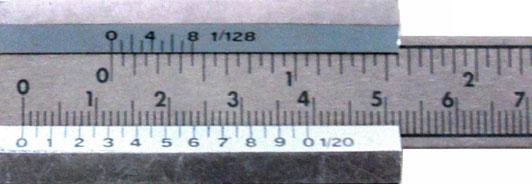
Fig.1.4 Thefigureshows20divisionsoftheVernierscalecovering39mmofthelowermain scale,sothatthedivisionsoftheVernierscaleareeach1.95mmlong
withthe n × 2mmdivisionofthemainscale,theVernierhasmovedadistanceof n × 0 05mm,correspondingtoareadingof n × 0 05mmonthemainscale.Clearly, for n = 20,theVernierscalehasmovedadistanceof20 × 0 05 = 1mm.Wehave takenthezeroofthemainscaleasthereferenceformeasuringthedistancemoved bytheVernierscale.However,itisclearthatwecanuseanymmdivisionofthe mainscaleasareferencefromwhichtotakethedistancemovedbytheVernierscale. Forexample,takethe7cm = 70mmdivisionofthemainscaleasthereference.If, say,the9thdivisionoftheVernierscaleisalignedwithadivisiononthemainscale, thenfromourconsiderationsearlier,wecansaythattheVernierscalehasmoveda distanceof9 × 0.05 = 0.45mmfromthe70mmdivision,andthecorresponding readingonthemainscaleis70 + 0.45 = 70.45mm = 7.045cm.Thisthenishow
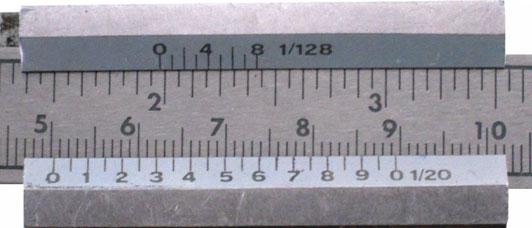
Fig.1.5 ReadingVerniercalipers.Thefigureshowsthatthelargestwholenumberofmmbefore thezerooftheVernierscaleis50mm.The7thdivisionoftheVernierscaleisalignedwithadivision ofthemainscale.Thereadingistherefore50 + (7 × 0 05) = 50.35mmor5.035cm
theVernierscalemeasuresfractionsofmillimetres.Withthisinmind,areadingon theVernierscaleistakenasfollows:
Thewholenumberofmillimetresinareadingistakenasthelargestnumberof millimetresonthemainscalebeforethezerooftheVernierscale.Thefractionofa millimetreisgivenbythedivisionoftheVernierthatisalignedwithadivisionofthe mainscale.Asanexample,letustakethereadingofthescalesoftheVerniercaliper showninFig. 1.5.Thefigureshowsthatthelargestwholenumberofmillimetres beforethezerooftheVernierscaleis5cm = 50mm.The7thdivisionoftheVernier scaleisalignedwithadivisionofthemainscale(whichparticularmainscaledivision hasnorelevance).Thus,thereadingis50 + (7 × 0 05) = 50 35mm.Asimplerway togetthesameresult,istoreadtheVernierscaleas0.35mm,immediatelygiving atotalreadingof50 + 0.35 = 50.35mm,asbefore.Thissimplifiedwayofreading theVernierscaleisachievedbynumberingeverytwodivisionsoftheVernierscale sothatthe20divisionsarenumberedfrom0to10.The0–10numberingofthe20 VernierscaledivisionsisshowninFigs. 1.1, 1.4,and 1.5.Wemayexpresstheabove lengthreadingasaformula:
whereMSisthemainscalereading,andVSistheVernierscalereading. SomeauthorsexpresstheVernierscalereadingsintermsoftheleastcount(LC) ofaninstrument,definedasthesmallestmeasurementthatcanbetakenwithan instrument,whichisgivenbytheformula
LC = valueofthesmallestdivisiononthemainscale totalnumberofdivisionsofthemainscale .
FortheVerniercalipersshowninFigs. 1.1, 1.4 and 1.5,theleastcountisLC = 1 20 = 0.05.WeseethattheLCisadimensionlessversionofthe0.05mmdifference between2mmofthemainscaleandthe1.95mmlengthoftheVernierscaledivisions.

Fig.1.6 Negativezerocorrection.Notethatthezeroofboththetop(inches)andlower(millimetres/centimetres)Vernierscaleistotheleftofthezerosofthemainscale.Sincethe8thdivision ontheVernierscaleisalignedwithadivisiononthemainscale,thenegativezerocorrectiontobe addedtotheVerniercaliperreadingis (8 × 0.05) = 0.4mm
AlookatthetopoftheguidebarinFigs. 1.1, 1.4,and 1.5 showsasecondinch scalewithasmallestdivisionof 1 16 in.Toreadfractionsof 1 16 in,theVernierhasa secondscaleatitstop.Theprincipleisexactlythesameasabove.Here,8divisions ofthetopVernierscalecover 7 16 inofthetopmainscale,sothateachdivisionofthe topVernierscalehasalength 7/16 8 = 7 128 in.Withthezerosofthetwoscalesaligned thefirsttopVernierdivisionisshortofthe 1 16 indivisionofthemainscaleby 1 128 in. TheleastcountoftheinchscaleisLC = 1/16 8 = 1 128 in.Asanexampleletustakethe readingfromthetopscalesshowninFig. 1.5.Themainscalereadingistakentobe thelargestnumberof 1 16 inbeforetheVernierzero,hereMS = 31 16 in = 1 15 16 in.Tofind thefractionalpartof 1 16 in,wecanstilluseformula(1.1),butwith0.05mmreplaced by 1 128 in.NotingthattheclosestVernierdivisionalignedwithmainscaledivision isthe5thVernierdivision,andUsingformula(1.1)withthe 1 128 inreplacement,our lengthreadingbecomes1 15 16 + 5 × 1 128 = 1 125 128 in.
Finally,weneedtoconsiderthezerocorrection.Whenthecaliperjawsareclosed thereadingshouldbezero.Ifitisnot,readingsmustbecorrected.Whenthezero oftheVernieristotheleftofthezeroofthemainscale,asshowninFig. 1.6,the zerocorrectionissaidtobenegative.Itisclearthatallreadingswillbeslightlylow. Henceanegativezerocorrectionmustbeaddedtotheobservedreading:
length = Verniercaliperreading + negativezerocorrection
WhenthezerooftheVernieristotherightofthezeroofthemainscale,asshownin Fig. 1.7,thezerocorrectionissaidtobepositive.Inthiscase,readingswillbeslightly high,sothatapositivezerocorrectionmustbesubtractedfromtheobservedreading:
length = Verniercaliperreading positivezerocorrection
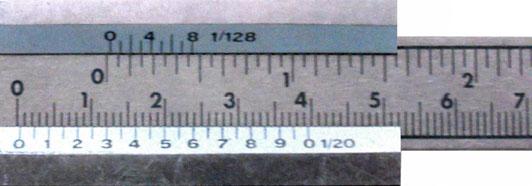
Fig.1.7 Positivezerocorrection.Notethatthezeroofboththetop(inches)andlower(millimetres/centimetres)Vernierscaleistotherightofthezerosofthemainscale.Sincethe8thdivision ontheVernierscaleisalignedwithadivisiononthemainscale,thepositivezerocorrectiontobe subtractedfromtheVerniercaliperreadingis (8 × 0.05) = 0.4mm
1.8.2TheMicrometer
Theprincipleofthemicrometerisbasedonthefactthatasascrewisturnedbyone revolution,itadvancesadistanceequaltoitspitch.Thepitchofthescrewisthedistancebetweenadjacentthreads.Whenfacingtheratchet,aclockwiserotationcloses themicrometer,whileananticlockwiserotationopensit.Typically,amicrometerhas ascrewofpitch0.5mmandathimblewith50divisions.Thus,turningthethimble1 divisionanticlockwise( 1 50th ofarotation)advances(opens)themicrometerspindle by 0 5 50 = 0.01mm.Thesleevescaleismarkedinmillimetresandhalfdivisionsof millimetres.Therefore,thesleevedivisionclosesttotheedgeofthethimblegives eitheranintegermillimetrereadingoranintegerplusahalfintegermillimetrereading,dependingonwhetherthedivisionisamillimetreorhalfmillimetredivision. Fractionsofahalfmillimetrearereadfromthethimble.Thethimblereadingisthe divisiononthethimblealignedwiththelinerunningalongthesleeve,whichwe willcallthereferenceline.Forexample,letustakethemicrometerreadingshown inFig. 1.8.Thenearestsleevedivisionbeforetheedgeofthethimbleisthe7mm division.Thethimbledivisionmostcloselyalignedwiththereferencelineisthe37th division.Themicrometerreadingistherefore7 + (37 × 0 01) = 7 37mm.Asanother example,considerreadingthemicrometershowninFig. 1.9 whichinvolvesahalf millimetresleevedivision.Here,thenearestsleevedivisionbeforethethimbleedge isthe6.5mmdivision.Thethimbledivisionliesalmostinthemiddlebetweenthe 23rdand24thdivisions,sowemaytake23.5astheclosestdivision.Themicrometer readingistherefore6.5 + (23.5 × 0.01) = 6.735mm.
AswiththeVernierscale,wemustconsiderthezerocorrectionforthemicrometer. Forafullyclosedmicrometertheedgeofthethimbleshouldbeexactlyalignedwith thezeroofthesleevewhenthezeroofthethimbleisalignedwiththereferenceline. Ifthezeroofthethimbleisabovethereferenceline,asshowninFig. 1.10,the zerocorrectionisnegativesothatobservedreadingsaretoolow.Again,anegative zerocorrectionmustbeaddedtotheobservedreading:

Fig.1.8 Readingamicrometer(I).Thenearestsleevedivisiontotheedgeofthethimbleisthe 7mmdivision.Thethimbledivisionmostcloselyalignedwiththereferencelineisthe37thdivision. Themicrometerreadingistherefore7 + (37 × 0 01) = 7 37mm
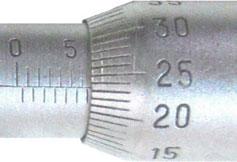
Fig.1.9 Readingamicrometer(II).Thenearestsleevedivisiontotheedgeofthethimbleisthe 6.5mmdivision.Thethimbledivisionliesalmostinthemiddlebetweenthe23rdand24thdivisions, sowemaytake23.5astheclosestdivision.Themicrometerreadingistherefore6 5 + (23 5 × 0 01) = 6 735mm
length = micrometerreading + negativezerocorrection
Ifthezeroofthethimbleisbelowthereferenceline,asshowninFig. 1.11,the zerocorrectionispositiveandtheobservedreadingsaretoohigh.Again,apositive zerocorrectionmustbesubtractedfromtheobservedreading:
length = micrometerreading positivezerocorrection
ForVerniercalipersitiseasytoseewhyazerocorrectionisnegativeorpositive, butforamicrometeralittlemorethoughtisneeded.Thetwofollowingexamples addressthisissue.
Example1.8.3 (Negativezerocorrection.Thezeroofthethimbleisabovethereferenceline.)
Toseewhyamicrometerwiththethimblezeroabovethereferenceline(negative zerocorrection)givestoolowareading,consideramicrometerwiththezeroabove thereferencelineby3divisions,i.e.,by3 × 0 01 = 0 03mm,asshowninFig. 1.10 Alsosupposethatthelengthofanobjecthasbeenmeasuredandtheobservedreading is6.1mm.Forthezeroofthethimbletoreachthereferencelinethespindlemovesa
Another random document with no related content on Scribd:
which all these impressions are made, and from which reactions come. Suppose there is something outside. I see the blackboard. How does the knowledge come? The blackboard itself is unknown, I can never know it. It is what the German philosophers call the “thing in itself.” That blackboard, that “X,” is acting on my mind, and the chitta reacts. The chitta is like a lake; throw a stone upon it, and as soon as the stone strikes it a reactionary wave comes towards the stone. This wave is what you really know. And this wave is not like the stone at all, it is a wave. So that blackboard, “X,” is the stone which strikes the mind and the mind throws up a wave towards that object which strikes it, and this wave which is thrown towards it is what we call the blackboard. I see you. You as reality are unknown and unknowable. You are “X” and you act upon my mind, and the mind throws a wave towards the point from which the action came, and that wave is what I call Mr. or Mrs. So-and-So.
There are two elements in this, one from inside and the other from outside, and the combination of these two, “X” plus mind, is our external universe. All knowledge is by reaction. In the case of a whale it has been determined by calculation how long after its tail is struck, its mind reacts upon the tail and the tail feels the pain. Take the case of the pearl oyster, in which the pearl is formed by the oyster throwing its own juice around the grain of sand that enters the shell and irritates him. There are two things which cause the pearl. First the oyster’s own juice, and second the blow from outside. So this table is “X” plus my mind. The very attempt to know it will be made by the mind; therefore the mind will give some of its own substance to enable it to understand, and when we understand it, it has become a compound thing,—“X” plus the mind. Similarly in internal perception; when we want to know ourselves. The real Self, which is within us, is also unknown and unknowable. Let us call it “Y.” When I want to know myself as Mr. So-and-So it is “Y” plus the mind. That “Y” strikes a blow on the mind, and when I want to know myself I must throw a blow upon the mind also. So our whole world is “X” plus mind (the external world), and “Y” plus mind (the internal world). We shall see later how this Advaitist idea can be demonstrated mathematically.
“X” and “Y” are simply the algebraic unknown quantities We have seen that all knowledge is a combination, and this world, the universe, is a combination, and intelligence is similarly a combination. If it is internal intelligence it is “Y” plus the mind, if an external object, it is “X” plus the mind. Knowledge is a combination of “Y” plus the mind and matter is a combination of “X” plus the mind. We first take the internal group. Intelligence which we see in Nature cannot be wholly in Nature, because intelligence itself is a compound of “Y” plus the mind. “Y” comes from the Self. So the intelligence that we know is a compound of the power of the light of the soul plus nature. Similarly, the existence which we know must be a compound of “X” plus the mind. We find therefore that in these three factors, I exist, I know and I am blessed, the idea that I have no want, which comes from time to time, is the central idea, the grand basic idea of our life, and when it becomes limited, and becomes a compound, we think it happiness and misery. These factors manifest as existence phenomenal, knowledge phenomenal, and love phenomenal. Every man exists, and every man must know, and every man is made for bliss. He cannot help it. So through all existence; animals and plants, from the lowest to the highest existence, all must love. You may not call it love; but they must all exist, must all know and must all love. So this existence which we know is a compound of “X” and the mind, and knowledge also is a compound of that “Y” inside plus mind, and that love also is a compound of that “Y” and mind. Therefore these three factors which come from inside and are combining themselves with the external things to manufacture phenomenal existence, knowledge and love, are called by the Vedantists “Existence Absolute, Knowledge Absolute, Bliss Absolute.”
That Absolute Existence which is limitless, which is unmixed, uncombined, which knows no change, is the free soul, and that Real Existence, when it gets mixed up, muddled up, as it were, with the elements of Nature is what we call human existence. It is limited and manifests as plant life, animal life, human life, just as infinite space is apparently limited by the walls of this room, or by any other enclosure. That Knowledge Absolute means not the knowledge we know, not intelligence, not reason, not instinct, but that which when it becomes manifested we call by these names. When that Knowledge
Absolute becomes limited we call it intuition, and when it becomes still more limited we call it reason, instinct, etc. That Knowledge Absolute is Vijnâna. The nearest translation of it is “all-knowingness.” There is no combination in it. It is the nature of the soul. That Bliss Absolute when it becomes limited we call love, attraction for the gross body, or the fine bodies, or for ideas. These are but distorted manifestations of this blessedness which is not a quality of the soul, but the essence, the inherent nature of the soul. Absolute Existence, Absolute Knowledge, and Absolute Blessedness are not qualities of the soul, but its essence; there is no difference between them and the soul. And the three are one; we see the one thing in three different lights. They are beyond all knowledge and by their reflection Nature appears to be intelligent.
It is that eternal Knowledge Absolute of the Self percolating through the mind of man that becomes our reason and intelligence. It varies according to the medium through which it is shining. There is no difference as soul between me and the lowest animal, only his brain is a poorer medium through which the knowledge shines, and we call it instinct. In man the brain is much finer, so the manifestation is much clearer, and in the highest man it has become entirely clear, like a piece of glass. So with existence; this existence which we know, this limited bit of existence is simply a reflection of that Existence Absolute which is the nature of the soul. So with bliss; that which we call love or attraction is but the reflection of the eternal blessedness of the Self, because with these manifestations come limitations, but the unmanifested, the natural, essential existence of the soul is unlimited, to that blessedness there can be no limit. But in human love there are limitations. I may love you one day, I may cease to love you the next. My love increases one day, decreases the next, because it is only a limited manifestation. The first thing therefore that we find against Kapila is that he conceives the soul to be a mere qualitiless, colorless, inactive something. Vedânta teaches that it is the essence of all Existence, Knowledge, and Bliss; infinitely higher than all knowledge that we know, infinitely more blessed than any human love that we can think of, infinitely existing. The soul never dies. Death and birth are simply unthinkable in connection with the Self, because it is Existence Absolute.
The second point where we will contend with Kapila is with regard to his idea of God. Just as this series of limited manifestations of Nature, beginning with the individual intellect and ending with the individual body, requires the Self behind as the ruler and governor on the throne, so in the Cosmos, we must enquire what the universal Intelligence, the universal Mind, the universal fine and gross materials have as their ruler and governor? How will that series become complete without one universal Self behind it as its ruler and governor? If we deny that there is a universal governor, we must deny there is a soul behind the lesser series, because the whole universe is a repetition of the same plan. When we know one lump of clay we know the nature of all clay. If we can analyze one human being, we shall have analyzed the whole universe, because it is all built on the same plan. Therefore if it be true that behind this individual series there stands one who is beyond all nature, who is not composed of materials, the purusha, the very same logic will apply to this universe, and this universe too will require such a Soul. The Universal Soul which is behind the modifications of Nature is called by Vedânta Isvara, the Supreme Ruler, God.
Now comes the more difficult point to fight. There can be but one Soul. To begin with, we can give the Sânkhyas a good blow by taking up their theories and proving that each soul must be omnipresent, because it is not composed of anything. Everything that is limited must be limited by something else. Here is the existence of the table. Its existence is circumscribed by many things, and we find that every limitation presupposes some limiting thing. If we think of space, we have to think of it as a little circle, but beyond that is more space. We cannot imagine a limited space in any other way. It can only be understood and perceived through the infinite. To perceive the finite, in every case we must apprehend the infinite; both stand or fall together. When you think of time, you have also to think of time beyond any particular period of time. The latter is limited time and the larger is unlimited time. Wherever you endeavor to perceive the finite, you will find it impossible to separate it from the infinite. If this be the case, we shall prove thereby that this Self must be infinite, omnipresent. Then comes a fine question. Can the omnipresent, the infinite be two? Suppose there are two infinites, one will limit the
other Suppose there are two infinites,—A and B; the infinite “A” limits the infinite “B,” because the infinite “B” you can say is not the infinite “A,” and the infinite “A” it can be said is not the infinite “B.” Therefore there can be but one infinite. Secondly, the infinite cannot be divided. Infinity divided into any number of parts must still be infinity, for it cannot be separated from itself. Suppose there is an infinite ocean of water, could you take up one drop from there? If you could, that ocean would no longer be infinite, that drop would limit it. The infinite cannot be divided by any means.
But there are stronger proofs that the Self is One. Not only so, but that the whole universe is one. We will once more take up our “X” and “Y”. We have shown how what we call the external world is “X” plus mind, and the internal world “Y” plus mind. “X” and “Y” are both unknown quantities, unknown and unknowable. What is the mind?
The mind is the “time, space and causation.” This idea is the nature of the mind. You can never think without time, you can never conceive of anything without space, and you can never imagine anything without causation. These three are the forms in which both “X” and “Y” are caught, and which become the mind. Beyond that there is nothing to the mind. Take off these three forms which of themselves do not exist,—what remains? It is all one; “X” and “Y” are one. It is only this mind, this form, that has limited them apparently, and made them differ as internal and external world. “X” and “Y” are both unknown and unknowable. We cannot attribute any quality to them. As such they are both the same. That which is qualitiless and attributeless and absolute must be one. There cannot be two absolutes. When there are no qualities there can be only One. “X” and “Y” are both without qualities because they take qualities only in the mind, therefore this “X” and “Y” are one.
The whole universe is One. There is only One Self in the universe, only One Existence, and that One Existence, when it is passing through the forms of time, space and causation, is called buddhi, fine matter, gross matter, etc. All physical and mental forms, everything in the universe is that One, appearing in various ways. When a little bit of it gets into this network of time, space and causation, it apparently takes forms; remove the network and it is all One. This whole
universe is all one, and is called in the Advaitist philosophy Brahman. Brahman appearing behind the universe is called God; appearing behind the little universe—the microcosm, is the soul. This very “Self” or Âtman therefore is God in man. There is only one Purusha, and He is called God, and when God and man are analyzed they are one. The universe is you yourself, the unbroken you; you are throughout this universe. “In all hands you work, through all mouths you eat, through all nostrils you breathe, through all minds you think.” The whole universe is you; this universe is your body; you are the universe, both formed and unformed. You are the soul of the universe, its body also. You are God, you are the angels, you are man, you are the animals, you are the plants, you are the minerals, you are everything; all manifestation is you. Whatever exists is you—the real “You”—the one undivided Self—not the little, limited personality that you have been regarding as yourself.
The question now arises,—how have you, that Infinite Being, broken into parts, become Mr. So-and-So, and the animals and so on? The answer is that all this division is only apparent. We know that the infinite cannot be divided, therefore this idea that you are a part has no reality, and never will have: and this idea that you are Mr. So-andSo was never true at any time; it is but a dream. Know this and be free. That is the Advaitist conclusion. “I am neither the mind, nor the body, nor am I the organs; I am Existence-Knowledge-Bliss Absolute; I am He, I am He,” This is knowledge, and everything besides this is ignorance. Everything that is, is but ignorance, the result of ignorance. Where is knowledge for me, for I am knowledge itself! Where is life for me, for I am life itself! Life is a secondary manifestation of my nature. I am sure I live, for I am life, the one Being, and nothing exists except through me, and in me, and as me. I am manifested through elements, but I am the one free. Who seeks freedom? Nobody seeks freedom. If you think that you are bound, you remain bound; you make your own bondage. If you realize that you are free, you are free this moment. This is knowledge, knowledge of freedom. Freedom is the goal of all Nature.
IV
THE FREE SOUL
We have seen that the analysis of the Sânkhyas stops with the duality of existence, Nature and souls. There are an infinite number of souls, which, being simple, cannot die, and must therefore be separate from Nature. Nature in itself changes and manifests all these phenomena, and the soul, according to the Sânkhyas is inactive. It is a simple by itself, and Nature works out all these phenomena for the liberation of the soul, and liberation consists in the soul discriminating that it is not Nature. At the same time we have seen that the Sânkhyas were bound to admit that every soul was omnipresent. Being a simple the soul cannot be limited, because all limitation comes either through time, space, or causation. The soul being entirely beyond these cannot have any limitation. To have limitation one must be in space, which means the body, and that which is body must be in Nature. If the soul had form, it would be identified with Nature; therefore the soul is formless, and that which is formless cannot be said to exist here, there, or anywhere. It must be omnipresent. Beyond this the Sânkhya philosophy does not go.
The first argument of the Vedantists against this is that this analysis is not a perfect one. If this Nature be a simple, and the soul is also a simple, there will be two simples, and all the arguments that apply in the case of the soul to show that it is omnipresent, will apply in the case of Nature, and Nature too will be beyond all time, space, and causation, and as the result there will be no change or manifestation. Then will come the difficulty of having two simples, or two absolutes, which is impossible. What is the solution of the Vedantist? His solution is that, just as the Sânkhyas say, it requires some sentient being as the motive power behind, which makes the mind think and Nature work, because Nature in all its modifications, from gross
matter up to Mahat (Intelligence) is simply insentient. Now, says the Vedantist, this sentient being which is behind the whole universe is what we call God, and consequently this universe is not different from Him. It is He Himself who has become this universe. He not only is the instrumental cause of this universe, but also the material cause. Cause is never different from effect, the effect is but the cause reproduced in another form. We see that every day. So this Being is the cause of Nature. All the forms and phases of Vedânta, either dualistic, or qualified-monistic, or monistic, first take this position,—that God is not only the instrumental but also the efficient cause of this universe, that everything which exists is He. The second step in Vedânta is that these souls are also a part of God, one spark of that Infinite Fire. “As from a mass of fire millions of small particles fly, even so from this Ancient One have come all these souls.” So far so good, but it does not yet satisfy. What is meant by a part of the Infinite? The Infinite is indivisible; there cannot be parts of the Infinite. The Absolute cannot be divided. What is meant therefore that all these sparks are from Him? The Advaitist, the non-dualistic Vedantist, solves the problem by maintaining that there is really no part; that each soul is really not a part of the Infinite, but actually is the Infinite Brahman. Then how can there be so many? The sun reflected from millions of globules of water appears to be millions of suns, and in each globule is a miniature picture of the sun-form; so all these souls are but reflections and not real. They are not the real “I” which is the God of this universe, the one undivided Being of the universe. And all these little different beings, men and animals, etc., are but reflections, and not real. They are simply illusory reflections upon Nature. There is but one Infinite Being in the universe, and that Being appears as you and as I, but this appearance of division is after all delusion. He has not been divided, but only appears to be divided. This apparent division is caused by looking at Him through the network of time, space, and causation. When I look at God through the network of time, space, and causation, I see Him as the material world. When I look at Him from a little higher plane, yet through the same network, I see Him as an animal, a little higher as a man, a little higher as a god, but yet He is the One Infinite Being of the universe, and that Being we are. I am
That, and you are That. Not parts of It, but the whole of It. “It is the Eternal Knower standing behind the whole phenomena; He Himself is the phenomena.” He is both the subject and the object, He is the “I” and the “You.” How is this? “How to know the knower?” The Knower cannot know himself. I see everything but cannot see myself. The Self, the Knower, the Lord of all, the Real Being, is the cause of all the vision that is in the universe, but it is impossible for Him to see Himself or know Himself, excepting through reflection. You cannot see your own face excepting in a mirror, and so the Self cannot see its own nature until it is reflected, and this whole universe therefore is the Self trying to realize Itself. This reflection is thrown back first from the protoplasm, then from plants and animals, and so on and on from better and better reflectors, until the best reflector,— the perfect man,—is reached. Just as a man who, wanting to see his face, looks first in a little pool of muddy water, and sees just an outline. Then he comes to clearer water, and sees a better image, then to a piece of shining metal, and sees a still better image, and at last to a looking-glass, and sees himself reflected as he is. Therefore the perfect man is the highest reflection of that Being, who is both subject and object. You now find why man instinctively worships everything, and how perfect men are instinctively worshipped as God in every country. You may talk as you like, but it is they who are bound to be worshipped. That is why men worship Incarnations, such as Christ or Buddha. They are the most perfect manifestations of the eternal Self. They are much higher than all the conceptions of God that you or I can make. A perfect man is much higher than such conceptions. In him the circle becomes complete; the subject and the object become one. In him all delusions go away and in their place comes the realization that he has always been that perfect Being. How came this bondage then? How was it possible for this perfect Being to degenerate into the imperfect? How was it possible that the free became bound? The Advaitist says he was never bound, but was always free. Various clouds of various colors come before the sky. They remain there a minute and then pass away. It is the same eternal blue sky stretching there forever. The sky never changes; it is the cloud that is changing. So you are always perfect, eternally perfect. Nothing ever changes your nature, or ever will. All
these ideas that I am imperfect, I am a man, or a woman, or a sinner, or I am the mind, I have thought, I will think, all are hallucinations; you never think, you never had a body; you never were imperfect. You are the blessed Lord of this universe, the one Almighty ruler of everything that is and ever will be, the one mighty ruler of these suns and stars and moons and earths and plants, and all the little bits of our universe. It is through you the sun shines, and the stars shed their lustre, and the earth becomes beautiful. It is through your blessedness that they all love and are attracted to each other. You are in all, and you are all. Whom to avoid, and whom to take? You are the all in all. When this knowledge comes delusion immediately vanishes.
I was once travelling in the desert in India. I travelled for over a month and always found the most beautiful landscapes before me, beautiful lakes and all that. One day I was very thirsty and I wanted to have a drink at one of these lakes, but when I approached that lake it vanished. Immediately with a blow came into my brain the idea that this was a mirage about which I had read all my life, and then I remembered and smiled at my folly, that for the last month all the beautiful landscapes and lakes I had been seeing were this mirage, but I could not distinguish them then. The next morning I again began my march; there was the lake and the landscape, but with it immediately came the idea, “This is a mirage.” Once known it had lost its powers of illusion. So this illusion of the universe will break one day. The whole of this will vanish, melt away. This is realization. Philosophy is no joke or talk. It will be realized; this body will vanish, this earth and everything will vanish, this idea that I am the body, or the mind, will for some time vanish, or if the Karma is ended it will disappear never to come back; but if one part of the Karma remains,—as a potter’s wheel after the potter has finished the pot, will sometimes go on from the past momentum—so this body, when this delusion has vanished altogether, will go on for some time. Again this world will come, men and women and animals will come, just as the mirage came the next day, but not with the same force, along with it will come the idea that I know its nature now, and it will cause no bondage, no more pain, nor grief, nor misery. Whenever anything miserable will come, the mind will be able to say, “I know
you as hallucination.” When a man has reached that state he is called jivan mukta, “living free,” free even while living. The aim and end in this life for the Jnâna Yogi is to become this jivan mukta, living freedom. He is jivan mukta who can live in this world without being attached. He is like the lotus leaves in water, which are never wet by the water. He is the highest of human beings, nay, the highest of all beings, for he has realized his identity with the Absolute, he has realized that he is one with God. So long as you think you have the least difference from God, fear will seize you, but when you have known that you are He, that there is no difference, entirely no difference, that you are He, all of Him, and the whole of Him, all fear ceases. “There who sees whom? Who worships whom? Who talks to whom? Who hears whom? Where one sees another, where one talks to another, where one hears another, it is in law. Where none sees none, where none speaks to none that is the highest, that is the great, that is the Brahman.” Being That, you are always That. What will become of the world then? What good shall we do to the world? Such questions do not arise. “What becomes of my gingerbread if I become old?” says the baby. “What becomes of my marbles if I grow, so I will not grow,” says the boy. “What will become of my dolls if I grow old?” says the little child. It is the same question in connection with this world; it has no existence in the past, present, or future. If we have known the Âtman as It is, if we have known that there is nothing else but this Âtman, that everything else is but a dream, with no existence in reality, then this world with its poverties, its miseries, its wickedness and its goodness will cease to disturb us. If they do not exist, for whom and for what shall we take trouble? This is what the Jnâna Yogis teach. Therefore, dare to be free, dare to go as far as your thought leads, and dare to carry that out in your life. It is very hard to come to jnânam. It is for the bravest and most daring, who dare to smash all idols, not only intellectual, but in the senses. This body is not I; it must go. All sorts of curious things may come out of this. A man stands up and says I am not the body, therefore my headache must be cured, but where is the headache if not in his body? Let a thousand headaches and a thousand bodies come and go. What is that to me? “I have neither birth nor death; father nor mother I never had; friends and foes I have none, because
they are all I; I am my own friend and I am my own enemy; I am Existence-Knowledge-Bliss Absolute; I am He, I am He.” If in a thousand bodies I am suffering from fever and other ills, in millions of bodies I am healthy. If in a thousand bodies I am starving, in other thousand bodies I am feasting. If in thousands of bodies I am suffering misery, in thousands of bodies I am happy. Who shall blame whom, who praise whom? Whom to seek, whom to avoid? I seek none, nor avoid any, for I am all the universe, I praise myself, I blame myself, I suffer for myself, I am happy at my own will, I am free. This is the Jnâni, brave and daring. Let the whole universe tumble down; he smiles and says it never existed. It was all an hallucination; we see the universe tumble down; where was it?
Where has it gone?
Before going into the practical part, we will take up one more intellectual question. So far the logic is tremendously rigorous. If man reasons, there is no place for him to stand until he comes to this, that there is but One Existence, that everything else is nothing. There is no other way left for rational mankind but to take this view. But how is it that what is infinite, ever perfect, ever blessed, ExistenceKnowledge-Bliss Absolute has come under these delusions? It is the same question that has been asked all the world over. In the vulgar form the question becomes “How did sin come into this world?” This is the most vulgar and sensuous form of the question, and the other is the more philosophic form, but the answer is the same. The same question has been asked in various grades and fashions, but in its lower forms it finds no solution, because the stories of apples and serpents and women do not give the explanation. In that state, the question is childish and so is the answer. But the question has assumed very high proportions now. “How this illusion came?” And the answer is as fine. The answer is that we cannot expect any answer to an impossible question. The very question is impossible in terms. You have no right to ask that question. Why? What is perfection? That which is beyond time, space and causation. That is perfect. Then you ask how the perfect became imperfect. In logical language the question may be put in this form—“How did that which is beyond causation become caused?” You contradict yourself. You first admit it is beyond causation, and then ask what causes it. This
question can only be asked within the limits of causation As far as time and space and causation extend, so far can this question be asked. But beyond that it will be nonsense to ask it, because the question is illogical. Within time, space and causation it can never be answered, and what answer may lie beyond these limits can only be known when we have transcended them, therefore the wise will let this question rest. When a man is ill, he devotes himself to curing his disease, without insisting that he must first learn how he came to have it.
There is another form of this question, a little lower, but more practical and illustrative. What produced this delusion? Can any reality produce delusion? Certainly not. We see that one delusion produces another, and so on. It is delusion always that produces delusion. It is disease that produces disease, and not health that produces disease. The wave is the same thing as the water, the effect is the cause in another form. The effect is delusion, and therefore the cause must be delusion. What produced this delusion? Another delusion. And so on without beginning. The only question that remains for you to ask is, does not this break your monism, because you get two existences in the universe, one yourself, and the other the delusion? The answer is,—delusion cannot be called an existence. Thousands of dreams come into your life, but do not form any part of your life. Dreams come and go; they have no existence; to call delusion existence will be sophistry. Therefore there is only one individual existence in the universe, ever free, and ever blessed, and that is what you are. This is the last conclusion reached by the Advaitists. It may then be asked, what becomes of all these various forms of worship? They will remain; they are simply groping in the dark for light, and through this groping light will come. We have just seen that the Self cannot see Itself. Our knowledge is within the network of Mâyâ (unreality), and beyond that is freedom; within the network there is slavery, it is all under law. Beyond that there is no law. So far as the universe is concerned, existence is ruled by law, and beyond that is freedom. As long as you are in the network of time, space and causation, to say you are free is nonsense, because in that network all is under rigorous law, sequence and consequence. Every thought that you think is caused,
every feeling has been caused; to say that the will is free is sheer nonsense. It is only when the infinite existence comes, as it were, into this network of Mâyâ that it takes the form of will. Will is a portion of that being caught in the network of Mâyâ, and therefore “free-will” is a misnomer. It means nothing,—sheer nonsense. So is all this talk about freedom. There is no freedom in Mâyâ.
Every one is as much bound in thought, word, deed, and mind, as a piece of stone or this table. That I talk to you now is as rigorously in causation as that you listen to me. There is no freedom until you go beyond Mâyâ. That is the real freedom of the soul. Men, however sharp and intellectual, however clearly they see the force of the logic that nothing here can be free, are all compelled to think they are free; they cannot help. No work can go on until we begin to say we are free. It means that the freedom we talk about is the glimpse of the blue sky through the clouds, and that the real freedom—the blue sky itself,—is behind. True freedom cannot exist in the midst of this delusion, this hallucination, this nonsense of the world, this universe of the senses, body and mind. All these dreams, without beginning or end, uncontrolled and uncontrollable, ill-adjusted, broken, inharmonious, form our idea of this universe. In a dream, when you see a giant with twenty heads chasing you, and you are flying from him, you do not think it is inharmonious; you think it is proper and right. So is this law. All that you call law is simply chance without meaning. In this dream state you call it law. Within Mâyâ, so far as this law of time, space and causation exists, there is no freedom, and all these various forms of worship are within this Mâyâ. The idea of God and the ideas of brute and of man are within this Mâyâ, and as such equally hallucinations; all of them are dreams. But you must take care not to argue like some extraordinary men of whom we hear at the present time. They say the idea of God is a delusion, but the idea of this world is true. Both ideas stand or fall by the same logic. He alone has the right to be an atheist who denies this world, as well as the other. The same argument is for both. The same mass of delusion extends from God to the lowest animal, from a blade of grass to the Creator They stand or fall by the same logic. The same person who sees falsity in the idea of God ought also to see it in the idea of his own body, or his own mind. When God vanishes, then
also vanish the body and mind, and when both vanish, that which is the Real Existence remains forever. “There the eyes cannot go, nor the speech, nor the mind. We cannot see it, neither know it.” And we now understand that so far as speech and thought and knowledge, and intellect go, it is all within this Mâyâ, within bondage. Beyond that is Reality. There neither thought, nor mind, nor speech, can reach.
So far it is intellectually all right, but then comes the practice. The real work in these classes is the practice. Are any practices necessary to realize this one-ness? Most decidedly. It is not that you become this Brahman. You are already that. It is not that you are going to become God or perfect; you are already perfect, and whenever you think you are not, it is a delusion. This delusion which says that you are Mr. So-and-So, or Mrs. So-and-So, can be got rid of by another delusion, and that is practice. Fire will eat fire, and you can use one delusion to conquer another delusion. One cloud will come and brush away another cloud, and then both will go away. What are these practices then? We must always bear in mind that we are not going to be free, but are free already. Every idea that we are bound is a delusion. Every idea that we are happy or unhappy, is a tremendous delusion; and another delusion will come,—that we have got to work and worship and struggle to be free,—and this will chase out the first delusion, and then both will stop.
The fox is considered very unholy by the Mohammedans, also by the Hindus. Also, if a dog touches any bit of food it has to be thrown out, it cannot be eaten by any man. In a certain Mohammedan house a fox entered and took a little bit of food from the table, ate it up and fled. The man was a poor man, and had prepared a very nice feast for himself, and that feast was made unholy, and he could not eat it. So he went to a Mulla, a priest, and said: “This has happened to me; a fox came and took a mouthful out of my meal; what can be done? I had prepared a feast and wanted so much to eat it, and now comes this fox and destroys the whole affair.” The Mulla thought for a minute, and then found only one solution and said: “The only way is for you to get a dog, and make him eat a bit out of the same plate, because dog and fox are eternally quarrelling. The food that was left
by the fox will go into your stomach, and that not eaten by the dog will go there, and both will be purified.” We are very much in the same Predicament. This is an hallucination that we are imperfect, and we take up another, that we have to practice to become perfect. Then one will chase the other, as we can use one thorn to extract another and then throw both away. There are people for whom it is sufficient knowledge to hear, “Thou art That.” With a flash this universe goes away and the real nature shines, but others have to struggle hard to get rid of this idea of bondage.
The first question is, who are fit to become Jnâna Yogis? Those who are equipped with these requisites. First, renunciation of all fruits of work and of all enjoyments in this life or another life. If you are the creator of this universe whatever you desire you will have, because you will create it for yourself. It is only a question of time. Some get it immediately; with others the past samskâras (impressions) stand in the way of getting their desires. We give the first place to desires for enjoyment, either in this or another life. Deny there is any life at all, because life is only another name for death. Deny that you are a living being. Who cares for life? Life is one of these hallucinations and death is its counterpart. Joy is one part of these hallucinations, and misery the other part, and so on. What have you to do with life or death? These are all creations of the mind. This is called giving up desires of enjoyment either in this life or another.
Then comes controlling the mind, calming it so that it will not break into waves and have all sorts of desires; holding the mind steady, not allowing it to get into waves from external or internal causes, controlling the mind perfectly just by the power of will. The Jnâna Yogi does not take any one of these physical helps, or mental helps, simply philosophic reasoning, knowledge and his own will, these are the instrumentality he believes in. Next comes Titikshâ, forbearance, bearing all miseries without murmuring, without complaining. When an injury comes, do not mind it. If a tiger comes, stand there. Who flies? There are men who practice titikshâ, and succeed in it. There are men who sleep on the banks of the Ganges in the mid-summer sun of India, and in winter float in the waters of the Ganges for a whole day; they do not care. Men sit in the snow of the Himâlayas,
and do not care to wear any garment. What is heat? What is cold? Let things come and go, what is that to me, I am not the body. It is hard to believe this in these Western countries, but it is better to know that it is done. Just as your people are brave to jump at the mouth of a cannon, or into the midst of the battle-field, so our people are brave to think and act out their philosophy. They give up their lives for it. “I am Existence-Knowledge-Bliss Absolute; I am He; I am He.” Just as the Western ideal is to keep up luxury in practical life, so ours is to keep up the highest form of spirituality, to demonstrate that religion is not merely frothy words, but can be carried out, every bit of it, in this life. This is titikshâ, to bear everything, not to complain of anything. I myself have seen men who say “I am the soul; what is the universe to me? Neither pleasure, nor pain, nor virtue, nor vice, nor heat, nor cold are anything to me.” That is titikshâ; not running after the enjoyments of the body. What is religion? To pray: “give me this and that”? Foolish ideas of religion! Those who believe them have no true idea of God and soul. My Master used to say the vulture rises high and high until he becomes a speck, but his eye is always in the piece of rotten carrion on the earth. After all, what is the result of your ideas of religion? To cleanse the streets, and have more bread and clothes. Who cares for bread and clothes? Millions come and go every minute. Who cares? Why care for the joys and vicissitudes of this little world? Go beyond that if you dare; go beyond law, let the whole universe vanish, and stand alone. “I am Existence-Absolute, Knowledge-Absolute, Bliss-Absolute; I am He; I am He.”
ONE EXISTENCE APPEARING AS
MANY
We have seen how Vairâgyam, or renunciation, is the turning point in all these various Yogas. The Karmi (worker) renounces the fruits of his work. The Bhakta (devotee) renounces all little loves for the almighty and omnipresent love. The Yogi renounces his experiences, because his philosophy is that the whole Nature, although it is for the experience of the soul, at last brings him to know that he is not in Nature, but eternally separate from Nature. The Jnâni (philosopher) renounces everything, because his philosophy is that Nature never existed, neither in the past, present nor future. We have also seen how the question of utility cannot be asked in these higher themes; it is very absurd to ask utility, and even if it be asked, after a proper analysis what do we find in this question of utility? The ideal of happiness, that which brings man greater happiness is of greater utility to him than those things which do not improve his material conditions or bring him such great happiness. All the sciences are for this one end, to bring happiness to humanity and that which brings the larger amount of happiness, mankind takes and gives up that which brings a lesser amount of happiness. We have seen how happiness is either in the body, or in the mind, or in the Âtman. With animals, and in the lowest of human beings, who are very much like animals, happiness is all in the body No man can eat with the same pleasure as a famished dog, or a wolf; so, in the dog and the wolf the happiness is gone entirely into the body. In men we find a higher plane of happiness, that of thought, and in the Jnâni there is the highest plane of happiness in the Self, the Âtman. So to the philosopher this knowledge of the Self is of the highest utility, because it gives him the highest happiness possible. Sense gratifications or physical things cannot be of the highest utility to him because he does not find in them the same pleasure that he finds in
knowledge itself; and after that, knowledge is the one goal, and is really the highest happiness that we know. All who work in ignorance are, as it were, the draught animals of the devas. The word deva is here used in the sense of a wise man. All the people that work, and toil, and labor like machines do not really enjoy life, but it is the wise man who enjoys. A rich man buys a picture at a cost of a hundred thousand dollars perhaps, but it is the man who understands art that enjoys it; and if a man is without knowledge of art it is useless to him, he is only the owner. All over the world, it is the wise man who enjoys the happiness of the world. The ignorant man never enjoys; he has to work for others unconsciously.
Thus far we have seen the theories of these Advaitist philosophers, how there is but one Âtman; there cannot be two. We have seen how in the whole of this universe there is but One Existence, and that One Existence when seen through the senses is called the world, the world of matter. When It is seen through the mind It is called the world of thoughts and ideas, and when It is seen as it is, then It is the One Infinite Being. You must bear this in mind; it is not that there is a soul in man, although I had to take that for granted in order to explain it at first, but that there is only One Existence, and that one the Âtman, the Self, and when this is perceived through the senses, through sense imageries, It is called the body. When It is perceived through thought, It is called the mind. When It is perceived in Its own nature, It is the Âtman, the One Only Existence. So, it is not that there are three things in one, the body and the mind and the Self, although that was a convenient way of putting it in the course of explanation; but all is that Âtman, and that one Being is sometimes called the body, sometimes the mind, and sometimes the Self, according to different vision. There is but one Being which the ignorant call the world. When a man goes higher in knowledge he calls the very same Being the world of thought. Again when knowledge itself comes, all illusions vanish, and man finds it is all nothing but Âtman. I am that One Existence. This is the last conclusion. There are neither three nor two in the universe; it is all One. That One, under the illusion of Mâyâ is seen as many, just as a rope is seen as a snake. It is the very rope that is seen as a snake. There are not two things there, a rope separate and a snake
separate. No man sees two things there. Dualism and non-dualism are very good philosophic terms, but in perfect perception we never perceive the real and the false at the same time. We are all born monists, we cannot help it. We always perceive the one. When we perceive the rope, we do not perceive the snake at all, and when we see the snake, we do not see the rope at all; it has vanished. When you see illusion, you do not see real men. Suppose one of your friends is coming from a distance in the street; you know him very well, but through the haze and mist that is before you, you think it is another man. When you see your friend as another man, you do not see your friend at all, he has vanished. You are perceiving only one. Suppose your friend is Mr. A., but when you perceive Mr. A. as Mr. B. you do not see Mr. A. at all. In each case you perceive only one. When you see yourself as a body, you are body and nothing else, and that is the perception of the vast majority of mankind. They may talk of soul and mind, and all these things, but what they perceive is the physical form, the touch, taste, vision, and so on. Again, with certain men, in certain states of consciousness, they perceive themselves as thought. You know, of course, the story told of Sir Humphrey Davy, who was making experiments before his class with laughing-gas, and suddenly one of the tubes broke, and the gas escaping, he breathed it in. For some moments he remained like a statue. Afterwards he told his class that when he was in that state, he actually perceived that the whole world is made up of ideas. The gas, for a time, made him forget the consciousness of the body, and that very thing which he was seeing as the body, he began to perceive as ideas. When the consciousness rises still higher, when this little puny consciousness is gone forever, that which is the Reality behind shines, and we see it as the One ExistenceKnowledge-Bliss, the one Âtman, the Universal. “One that is only knowledge itself, One that is bliss itself, beyond all compare, beyond all limit, ever free, never bound, infinite as the sky, unchangeable as the sky Such an One will manifest Himself in your heart in meditation.”
How does the Advaitist theory explain all these various phases of heavens and hells and all these various ideas we find in all religions? When a man dies it is said that he goes to heaven or hell, goes here
